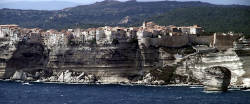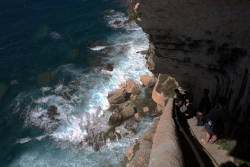Grotte du Puits Saint Barthélémy
Useful Information

| Location: |
7 Pl. Carrega, 20169 Bonifacio,
(41.3866463, 9.1534201) |
| Open: |
Escalier du Roy d’Aragon:
APR to NOV daily 10-16, last entry 17:30. [2023] |
| Fee: |
Adults EUR 5, Children (6-11) EUR 2, Children (0-5) free. Groups (10+): Adults EUR 4, Children (6-11) EUR 2. [2023] |
| Classification: |
 Karst Cave Karst Cave
 Karst Spring Karst Spring
 Water Supply Water Supply
|
| Light: | bring torch |
| Dimension: | |
| Guided tours: |
self guided.
D=30 min.



|
| Photography: | allowed |
| Accessibility: | no |
| Bibliography: | |
| Address: | Grotte du Puits Saint Barthélémy, 7 Pl. Carrega, 20169 Bonifacio, Tel: +33-495-73-11-88. |
| As far as we know this information was accurate when it was published (see years in brackets), but may have changed since then. Please check rates and details directly with the companies in question if you need more recent info. |
|
History
| 1420 | staircase dug by King Alfonso of Aragon’s troops in a single night during the siege of the city. |
| 1668 | a project to drill a well on the Bonifacio plateau gave rise to a sketch which was sent to Genoa. |
| 1852-1856 | 65 m deep well drilled by the Military Engineering. |
| 1994 | staircase and Well St.Barthélemy declared a Historical Monument. |
Description


The Grotte du Puits Saint Barthélémy (Cave of the Saint Barthélémy Well) is located at the foot of the cliff on the southern side of the Bonifacio peninsula. In Corsican, it is known as u Puzzu San Bartumià. This is actually the karst water table of the peninsula, which is fortunately 4 m higher than the sea level, which is the reason why the water is not mixed with seawater. The cave is not a sea cave, the entrance is located about 4 m above sea level. The first section is dry and freely accessible. The rear section is water filled and gated.
The cave is reached on a trail which starts at the Escalier du roi d’Aragon and ends at the cave entrance. According to legend, the staircase was dug in 1420 by King Alfonso of Aragon’s troops in a single night during the siege of the city. In reality, the stairs are much older. They already existed at that time, and if the besiegers used the staircase they were not successful. After five months of siege, Genoa came to the aid of the port city and pushed back the Spanish.
The staircase starts at the southwestern corner of the city. Parking at the monument aux morts, it’s a five minutes walk down Rue de L’Hopital, across place Carrega, and down a signposted narrow passage to the cliff. The staircase is cut into the soft Cretaceous limestone and climbs down to sea level on 187 steps in a 45° angle. The passage is sometimes quite low, so a helmet is much recommended. There is a plateau at the foot of the staircase, about 10 m asl, from which the sea can be reached down a shorter staircase at the eastern end. However, it seems this part of the trail is not maintained any more and thus gated. To the west a 220 m long trail leads to the cave. Again the trail, which continues along the wall above the cave entrance is gated. The continuation of the narrow trail is not maintained and has no railing.
The cave is located right below the Ancienne église Saint-Barthélémy, after which it was named. It seems the well in the cave was the source of drinking water for the Franciscan monks at the church. Its unclear how the spring was discovered, most likely by boat from the sea. Its also not clear if it was used before the staircase was built, probably also only by boat. The Escalier du roi d’Aragon was most likely created by the Franciscan monks to access the drinking water, well before the siege by King Alfonso of Aragon.
But the karst spring is not only accessible from outside but also from inside. The Puits Saint Barthélémy (Saint Barthélémy Well) is actually a circular well with a spiral staircase with 340 steps around it. The hole in the center has a diameter of 3 m and is 60 m deep. It ends on the cave lake. It was built in the middle of the 19th century by military engineers to reach the freshwater spring located a few meters above sea level. The spring provided drinking water for the barracks west of the church.
The first attempt to build a well was in 1668. A sketch of the proposal was sent to Genoa, but the brotherhood of Saint Barthélemy intervened, because they feared that the work would jeopardize their nearby oratory. The actual construction of the well was projected in 1837, the drilling started on 03-NOV-1857, and lasted six and a half months, resulting in 60 m deep shaft with a diameter of 7 m. Its construction was completed in 1860, after a spiral staircase was built on the outside of the shaft, for maintenance. The staircase has six rests, approximately every nine meters. At the beginning, water was pulled on surface using a closed chain with buckets powered by a blindfolded revolving mule. Then the water was pumped by a windmill which was placed on top of the well. Later the windmill was replaced by a gasoline engine powered pump which was then followed by an electrically operated submersible pump. The pumped water was stocked in a cistern. The spring is not used any more because today the water is actually a bit brackish, obviously the result of depletion. The quantity of fresh water reaching and replenishing the aquifer decreased dramatically, because the city sealed much of the catchment area, and the buildings all had cisterns for rainwater, which thus never reached the aquifer. Stormwater running down the streets and sewers is lost to the sea, and also the rainfall decreased in the last centuries.
The well is open only on special tours after appointment. There are plans to open the round trip with the well, the spring, the walk along the cliff and the way back up on the Escalier du roi d’Aragon on a regular basis. However, those plans are made for numerous years and so far have not been realized. Currently only the Escalier du roi d’Aragon and the outer part of the cave are accessible, the well is closed by a gate.
We were struggling to classify the site, and so we finally classified it as a cave, but actually there is a cave, a karst spring, and an artificial well. The number of visitors is restricted to 50 per 30 minutes. The site is closed in case of yellow alert which means strong wind, and during heavy rains, because the stairway becomes dangerous. Helmets are provided.
- See also
 Search DuckDuckGo for "Grotte du Puits Saint Barthélémy"
Search DuckDuckGo for "Grotte du Puits Saint Barthélémy" Google Earth Placemark
Google Earth Placemark Bonifacio, Corse-du-Sud - Wikipedia (visited: 29-JAN-2023)
Bonifacio, Corse-du-Sud - Wikipedia (visited: 29-JAN-2023) Marine and millennial grottos (visited: 29-JAN-2023)
Marine and millennial grottos (visited: 29-JAN-2023) The King of Aragon’s Stairway (visited: 29-JAN-2023)
The King of Aragon’s Stairway (visited: 29-JAN-2023) The cave and well of Saint Barthelemy (visited: 29-JAN-2023)
The cave and well of Saint Barthelemy (visited: 29-JAN-2023) DÉCOUVERTE DU PUITS SAINT BARTHÉLEMY PAR MARIE JO CULIOLI VICHERA
DÉCOUVERTE DU PUITS SAINT BARTHÉLEMY PAR MARIE JO CULIOLI VICHERA  (visited: 29-JAN-2023)
(visited: 29-JAN-2023) L’ESCALIER ET LE PUITS SAINT BARTHELEMY
L’ESCALIER ET LE PUITS SAINT BARTHELEMY  (visited: 29-JAN-2023)
(visited: 29-JAN-2023)
 Index
Index Topics
Topics Hierarchical
Hierarchical Countries
Countries Maps
Maps